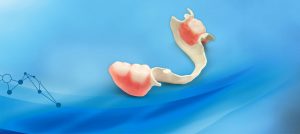Managing denture-related stomatitis – Phillip Silver Solvay 360
Featured Products Promotional FeaturesPosted by: Dental Design 16th January 2020

 Removable partial dentures are a popular option for replacing missing teeth. Usually, they are designed with a plastic or metal framework with prosthetic teeth attached that mimic the existing teeth in shape, size and colour. They restore aesthetics and are created to fit and function like regular teeth to improve chewing, bite and speaking capabilities. Natural-looking removable dentures offer a cost-effective solution for oral rehabilitation, which make patients feel more comfortable and confident and help to improve their quality of life.[1],[2]However, dentures produce environmental changes in the oral mucosa that can assist the proliferation and the colonisation of microorganisms, particularly yeast.[3] Furthermore, like natural teeth, dentures are substrates for biofilms, which over time can be colonised by Candida albicans, a pathogenetic fungus that is commonly associated with denture stomatitis.[4]
Removable partial dentures are a popular option for replacing missing teeth. Usually, they are designed with a plastic or metal framework with prosthetic teeth attached that mimic the existing teeth in shape, size and colour. They restore aesthetics and are created to fit and function like regular teeth to improve chewing, bite and speaking capabilities. Natural-looking removable dentures offer a cost-effective solution for oral rehabilitation, which make patients feel more comfortable and confident and help to improve their quality of life.[1],[2]However, dentures produce environmental changes in the oral mucosa that can assist the proliferation and the colonisation of microorganisms, particularly yeast.[3] Furthermore, like natural teeth, dentures are substrates for biofilms, which over time can be colonised by Candida albicans, a pathogenetic fungus that is commonly associated with denture stomatitis.[4]
Denture stomatitis
Denture stomatitis is a visible oral infection which is characterised by redness and inflammation of the oral mucosa that is covered by a dental appliance. The oral environment under a denture is more acidic and less exposed to the cleansing action of saliva. This has the potential to promote Candidaenzymatic activity, which may cause inflammation in the mucosa.
The exact aetiology of the condition is unknown, but studies suggest that it is likely to be caused by one the following factors: poorly fitting dentures, poor oral or denture hygiene, constant denture wear (including night-time), or bacterial and yeast infection with Candida albicans.[5],[6] Similarly, patients that take medication such as antidepressants, inhaled corticosteroids and drugs that cause dry mouth may be at an increased risk of developing stomatitis. Cigarette smokers are also at a higher risk.6
It has been reported that more than 65 per cent of denture wearers experience stomatitis.4 However, symptoms can vary in severity from asymptomatic to painful and irritating. On occasion, overgrowth of Candidacan be very severe and may cause symptoms such as swelling and discomfort, altered taste, difficulty swallowing or a burning sensation in the mouth.[7]
Antifungal agents are commonly used to treat denture stomatitis, which are effective in alleviating the clinical signs and symptoms of the infection. Nevertheless, reoccurrence is frequently reported as the widespread use of these agents has resulted in many anti-fungal resistant Candidaspecies.3
Although it can sometimes be a challenge to control, denture stomatitis does not usually have any long-lasting consequences. However, more recently it has been associated with endothelial dysfunction and it has been recommended that patients with denture stomatitis should be carefully monitored for cardiovascular disease.7
Contact stomatitis
An inflammatory reaction on the oral mucosa beneath a denture can be caused by contact or exposure to an allergen. It is characterised by redness, blistering, ulceration, pain, itchiness or a burning sensation.[8]This may be in response to materials used to fabricate the denture or to substances within products such as denture adhesives.
With44% of British adults now suffering from at least one allergy,[9]this is an area that should be carefully considered when selecting dental materials and components. For example, it has been estimated that up to 17 per cent of women and 3 per cent of men are allergic to nickel and up to 3 per cent of people are allergic to cobalt and chromium.[10]Indeed, many instruments and materials commonly used in dentistry contain metal alloys and the potential for an allergic reaction may be sizable.[11]Consequently, clinicians need to be able to choose from a range of safe and appropriate denture materials to meet the needs of each and every patient.
Harmony
 As both clinicians and patients agree, appliances such as removable partial dentures should exist in harmony within the oral cavity. Therefore, having the right material for the right application is fundamental. Accordingly, Solvay Dental 360® has custom developed a high-performance polymer specifically for the fabrication of removable partial denture frames. Ultaire® AKP is a new generation material that has superior biofilm resistance (Candida albicans)[12]and is both monomer and metal free to reduce sensitivity issues.
As both clinicians and patients agree, appliances such as removable partial dentures should exist in harmony within the oral cavity. Therefore, having the right material for the right application is fundamental. Accordingly, Solvay Dental 360® has custom developed a high-performance polymer specifically for the fabrication of removable partial denture frames. Ultaire® AKP is a new generation material that has superior biofilm resistance (Candida albicans)[12]and is both monomer and metal free to reduce sensitivity issues.
As well as offering patients a lightweight alternative to metal or bulky plastic denture frames, Ultaire AKP has strength to withstand loading as well as elasticity to offer stable retention with increased comfort and a natural feel.
Every effort should be made to design dentures that are comfortable, aesthetic and permit optimal oral hygiene as well as providing good retention and stability. Therefore, dental professionals should explore the new generation of materials and technology to ensure that they can confidently prescribe dentures that do not cause discomfort but enhance their patients’ quality of life.
To book a Solvay Dental 360® Professional Lunch and Learn or to find more information Ultaire® AKP and Dentivera® milling discs, please visit www.solvaydental360.com
References
NB: for editor – For online publication please can use this link:
https://www.solvaydental360.com/virtualmeeting/?lang=en_gb
[1]Xie Q. et al. Rehabilitation of oral function with removable dentures – still an option? Journal of Oral Rehabilitation 2015; 42(3) 234-242. https://onlinelibrary.wiley.com/doi/abs/10.1111/joor.12246[Accessed 16th October 2019]
[2]Kolciuk L. et al. Influence of removable dentures on quality of life. Dent. Med. Probl. 2015; 52(2) 222–226. http://www.dmp.umed.wroc.pl/pdf/2015/52/2/222.pdf[Accessed 16th October 2019]
[3]Garcia de Oliveira Mima E. et al. Denture stomatitis treated with photodynamic therapy: five cases. Oral Surgery, Oral Medicine, Oral Pathology, Oral Radiology and Endodontology. 2011;112(5) 602-608 https://www.sciencedirect.com/science/article/pii/S1079210411003477#bib1[Accessed 16th October 2019]
[4]Berger D. et al. Oral biofilms: development, control and analysis. High Throughput. 2018 Sep; 7(3): 24. https://www.ncbi.nlm.nih.gov/pmc/articles/PMC6163956/#B9-high-throughput-07-00024[Accessed 16th October 2019]
[5]Walsh T. et al. Interventions of managing denture stomatitis. Cochrane Database of Systematic Reviews 2015; Issue 10. Art. No.: CD011920. https://www.cochranelibrary.com/cdsr/doi/10.1002/14651858.CD011920/epdf/full[Accessed 16th October 2019]
[6]Shulman J.D. et al. Risk factors associated with denture stomatitis in the United States. Oral Pathology & Medicine 2005; 34(6) 340-346. https://onlinelibrary.wiley.com/doi/abs/10.1111/j.1600-0714.2005.00287.x[Accessed 16th October 2019]
[7]Maciąg J. et al. Denture related stomatitis is associated with endothelial dysfunction
Journal of Biomedicine and Biotechnology 2014; (12):474016. https://www.researchgate.net/publication/264091950_Denture-Related_Stomatitis_Is_Associated_with_Endothelial_Dysfunction[Accessed 16th October 2019]
[8]Feller L. et al. Review: allergic contact stomatitis. Oral Surgery, Oral Medicine, Oral Pathology, Oral Radiology 2017: 123(5) 559-565. https://www.oooojournal.net/article/S2212-4403(17)30066-4/pdf[Accessed 16th October 2019]
[9]Allergy UK. Allergy Prevalence: Useful facts and figures: https://www.allergyuk.org/assets/000/001/369/Stats_for_Website_original.pdf?1505209830and Statistics: https://www.allergyuk.org/information-and-advice/statistics [Accessed 16th October 2019]
[10]Thyssen JP et al. Metal allergy–a review on exposures, penetration, genetics, prevalence, and clinical implications. Chem Res Toxicol. 2010 Feb 15;23(2):309-18. https://www.ncbi.nlm.nih.gov/pubmed/19831422[Accessed 16th October 2019]
[11]Teo Z.W.W. et al, Hypersensitivity reactions to implanted metal devices: Facts and Fictions. J Investig Allergol Clin Immunol 2016; Vol. 26(5): 279-294. http://www.jiaci.org/revistas/vol26issue5_1_1.pdf[Accessed 16th October 2019]
No Comments
No comments yet.
Sorry, the comment form is closed at this time.



